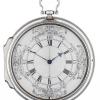Fusee English Lever Pocket Watch Reassembly - Part 1
-
Recently Browsing
- No registered users viewing this page.
-
Topics
-
Posts
-
By Neverenoughwatches · Posted
Just got these good quality diamond files from the bay for Just a fiver, we all love a bargain dont we. Brand names are J.K.Smit and Triefus, two old diamond tool makers so not cheap crap. -
By Neverenoughwatches · Posted
Its a touch under ive just remeasured it and added a wrist shot. Unbelievably it was £13 plus 3 postage. You dont find watches that nice for that money every day of the week. Maybe removing the epilame in the oil region improves the purpose of it. We may know very soon as i emailed Episurf 4 hours ago to ask that exact question. 🤞they are happy to provide an answer for us. How do you fancy trying a stearic acid vapour treatment experiment H . Shall i have a go this afternoon ? Stearic acid experiment underway, its started to melt at around 65° C. The idea is to find a large cap jewel to suspend over the vapour release. -
That's the size of my grandfather's Ernest Borel watch. Definitely not a lady's watch! 👍
-
By Neverenoughwatches · Posted
Thanks H It does have a big crown for the watch , it could be considered a ladies watch these days i guess, it measures 33mm case 36mm with that large crown 18mm lug space. A tad small for a guy of today, but still very wearable. The photo was deceptive so here it is adorning my 7 1/4 " wrist. It need some love to make it run better. The hair coils are touching so running a bit fast at the moment, not caused by magnetism, and maybe just a clean and a service. The dtal is in fantastic shape. -
That's one beautiful timepiece! Love the big crown in proportion to the case. Perhaps a ladies' watch, but I don't think so. I have a "modern Ingersoll" watch, but it has nothing to do with the original brand (Miyota 9015 movement). Interesting synonym for synthetic oils! 😆 There is, of course, a limit to how large a volume of oil epilame can bind and hold in place. If the oleophobic effect is too strong then it can become a problem. I'm not sure where I heard or read it, but as I understand it, the active ingredient in a bottle of epilame is extremely small and more than 99% of the contents of the bottle is just a transfer agent. If the active ingredient becomes too concentrated, which it can become over time, or if the product is of poor quality, the oleophobic effect is amplified. This in turn causes the applied oil to look like a gummed-up ball on the surface of the treated part. If that happens, we know that the active ingredient has become too concentrated. What we want is for the oil to bind but not to the point where it is formed into an excessively round ball on the surface. The highlighted text in the patent that you refer to describes well the problem that can arise with too high a concentration of the active ingredient. However, I would be extremely surprised if the entire amount of oil leaves the treated surface as water on wax would. At present, I am convinced that the analogy between wax and water on the one hand and epilame and oil on the other is incorrect. Epilame is described as binding and that is also my absolute experience. Epilame probably has some repelling effect but that is not its main purpose and that is not how epilame is designed and works. The method of abrading the epilame treatment from the section of the pallet stones coming in contact with the escape wheel teeth seems after even more research to be well established, but if it actually works, if so how and why is beyond what I can currently understand. Perhaps it is just to do and trust that it is based on well-established experience. I am, after all, inclined to think so.
-






Recommended Posts